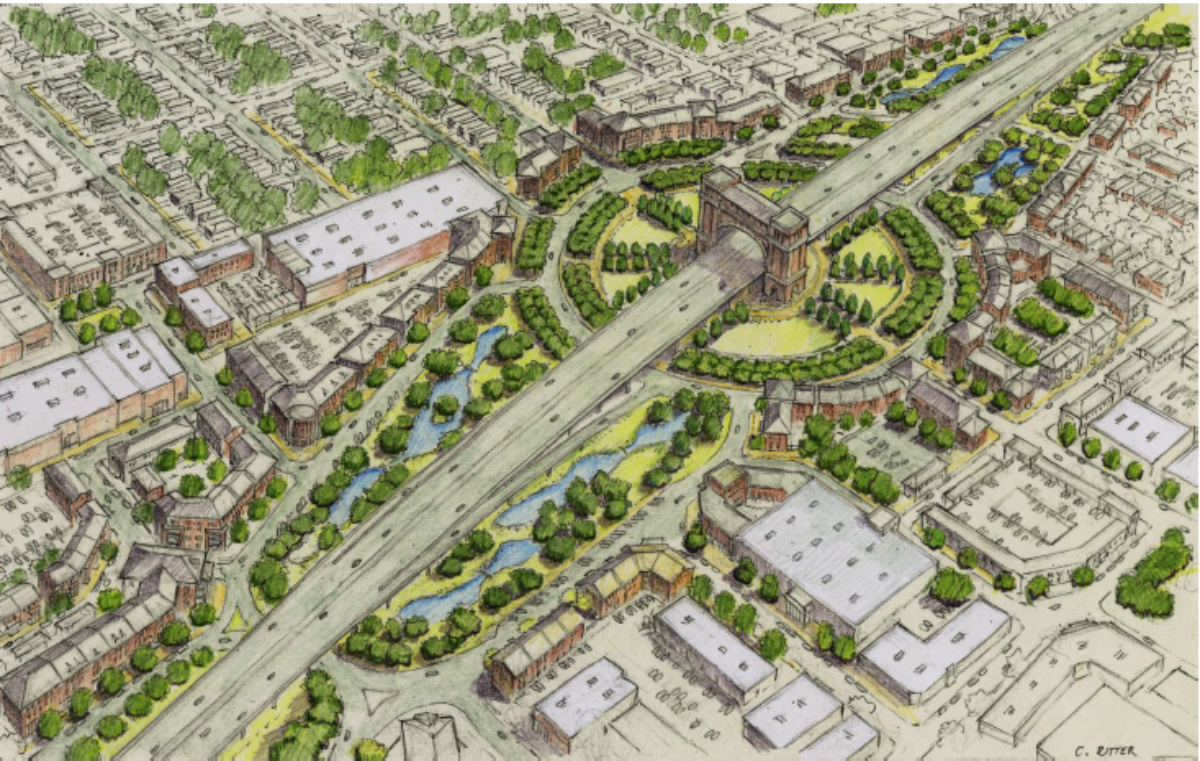Updated…scroll to bottom.
This is a development that could have huge ramifications for the Connector freeway down the road; enough so to further inflame and incite support for the Teche Ridge Bypass if officials don’t resolve this quickly.
The Advertiser just reposted an article from KLFY.com (the local Lafayette CBS TV affiliate) on an ongoing lawsuit being litigated against the Union Pacific Railroad over the former Southern Pacific Railroad distribution yard facility near Johnston Street. The lawsuit claims that the former railyard site is now a source of potential contamination of the Chicot Aquifer, which is the sole source for Lafayette’s drinking water. This directly impacts the Connector freeway because the approved alternative from the 2003 Record of Decision and the modifications proposed during the current Conceptual Design Study and Supplemental Environmental Impact Statement processes all traverse some portion of the former railyard property between Johnston Street and Taft Street.
On Wednesday, one of the lawyers mitigating the lawsuit announced in a press conference that he had confirmed that some contamination of the Aquifer did indeed take place at the railyard, and that some of the contaminating substances had made their way into one of Lafayette’s water well intakes.
Here is some snippets from the KLFY article, that was also reposted over at the Lafayette Advertiser:
Water well 16 in Lafayette has tested positive for contamination, and now the city is being advised to take action to keep contaminated drinking water from reaching residents.
Lawyer William Goodell gave a stern warning to the city and its residents Wednesday night, KLFY reports.
“Me and my co-counsel are here to get this aquifer cleaned up, and to protect the environment, and we are not going to go away till it’s cleaned up,” said Goodell.
Goddell did note that the contamination was not serious enough as of now to warrant danger, but without immediate remediation and cleanup, things could get worse.
The ramifications for the Connector freeway are huge, and potentially even fatal, due to the ROW of the potential freeway traversing the SP rail yard property. Environmental regulations require that “brownfield” sites found to have induced contamination must be fully remediated and cleaned up before any construction of a facility can begin; or, if remedial steps to prevent contamination can’t be found, alternative routes that avoid the contaminated area must be sought. The original 2003 ROD for the Connector does acknowledge the possibility of contamination of the SP/UP rail site, but states that standard practices, special construction techniques, and direct consultation with the federal EPA and the state Department of Environmental Quality (LaDEQ) can be used to protect the aquifer from contamination.
Nevertheless, opponents of the Connector project have cited the protection of the Chicot Aquifer as one of the main reasons for opposing the freeway project and re-routing the freeway around Lafayette, mostly supporting the Teche Ridge Bypass alternative running east along St. Martin Parish. One of the plantiffs in the current lawsuit is the Greater Lafayette Sierra Club, which has been one of the principal leads in opposition to the Connector project.
What could make this a possibly fatal blow to the project is that if it is found that contamination has reached the level of the aquifer, which is based nearly 40 feet below ground level and protected by a clay layer, it would make it less effective to merely remove and process elsewhere contaminated soils. The standard procedure for minor contamination is either to dig up the contaminants, or dig down to a certain level (usually 15 feet), cap with a concrete or other barrier, then replace with clean soils. Special techniques for drilling for pilings that would hold the piers needed to maintain the elevated structures required for the freeway would protect against future contamination.
The problem is, though, if the contamination is so severe that it is directly penetrating the aquifer levels, then merely digging out becomes impossible, and only an “in place” remediation is possible. In that case, the project would have to be moved or adjusted to avoid entirely the contaminated site.
It is possible that a full cleanup can be done for the SP/UP facility prior to construction of the Connector facility, avoiding the need for moving the facility. Indeed, the regulations for constructing the facility requires a full remediation before one inch of soil can be turned.
However, this development does give a huge hammer to those who oppose the Connector, and probably clinches the likelihood of a second lawsuit against FHWA and LADOTD to block the expected approval of the refined RR-4 alternative and for restarting studies to include Teche Ridge. The first lawsuit was filed in 2003 after the initial ROD, but was thrown out in Federal court, including an appeal that was turned down.
As always, more on this development here as it breaks.
UPDATE (1-14-2017):
I recently discovered this press release from attorney William J. Goddell, Jr., who is the lead attorney for the plaintiffs filing the suit against Union Pacific Railroad among others over the contamination of Lafayette water supply from the former Southern Pacific Railroad rail yard property. It details the level of contamination that Goddell’s research found at the former rail yard site, and the expectation for further documentation from both the state Department of Environmental Quality (DEQ) and Lafayette Consolidated Government’s Lafayette Utilities System (LUS), which oversees the local protection of the Chicot Aquifer. Again, this is important because the rail yard site cuts directly through the approved alignment of the Connector freeway, and the fear of breaching the protection for the aquifer through driving piles for the proposed alignment is one of the principal objections by those opposing the project and supporting alternatives such as the Teche Ridge or Lafayette Regional Expressway bypasses.
The original document was released by Goddell at a December 14, 2016, press conference that was covered by KATC-TV; their report is here. The report also includes a snippet of Goddell speaking at the press confrence.
